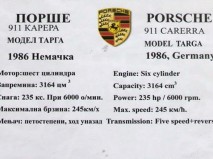1986 Porsche 911
Engine : Six cylinder
Capacity: 3164 cc
Power : 235 hp / 6000 rpm
Max. speed: 245 km/h
Transmission : Five speed+revers
en.wikipedia.org
The Porsche 911 is the flagship of the current line up of Porsche. It is a two-door, high performance sports car made by Porsche AG of Stuttgart, Germany. It has a distinctive design, rear-engined and with independent rear suspension, an evolution of the swing axle on the Porsche 356. Since its introduction in 1963, it has undergone continuous development, though the basic concept has remained little changed. The engine was air-cooled until the introduction of the Type 996 in 1998.
Throughout its lifetime, the 911 has been modified by private teams and by the factory itself for racing, rallying and other forms of automotive competition. It is among the most successful competition cars ever. In the mid-1970s, naturally aspirated 911 Carrera RSRs won major world championship sports car races such as Targa Florio, Daytona, Sebring and Nürburgring, even against prototypes. The 911-derived 935 turbo also won the coveted 24 Hours of Le Mans in 1979.
With the 911's future ensured, 1984 saw the launch of a replacement for the successful SC series. It was the model year 1984 911 3.2 Carrera, reviving the Carrera name for the first time since 1977. The 911 3.2 Carrera was the last iteration in the original 911 series, with all subsequent models featuring new body styling with new brake, electronic and suspension technologies.
A new higher-displacement motor, a 3.2-liter horizontally opposed flat 6-cylinder, was utilized. At the time Porsche claimed it was 80% new. The new swept volume of 3164 cc was achieved using the 95 mm (3.7 in) bore (from the previous SC model) combined with the 1978 Turbo 3.3 crankshaft's 74.4 mm (2.9 in) stroke. In addition, higher domed pistons increased the compression ratio from 9.8 to 10.3:1 (although only 9.5:1 for the US market). New inlet manifold and exhaust systems were fitted. The 915 transmission was carried over from the SC series for the first three model years. In 1987, the Carrera got a new five-speed gearbox sourced from Getrag, model number G50 with proven BorgWarner synchronizers. This slightly heavier version also featured a hydraulically operated clutch.
With the new engine, power was increased to 207 bhp (154 kW; 210 PS) (@ 5900 rpm) for North American-delivered cars and to 231 bhp (172 kW; 234 PS) (@ 5900 rpm) for most other markets. This version of the 911 accelerated 0–60 mph (100 km/h) in 5.4 seconds and had a top speed of 150 mph (242 km/h) as measured by Autocar. Factory times were more modest: 0–60 mph time of 6.3 seconds for the US version and 6.1 seconds for cars outside the American market.
The brake discs were increased in size to aid in more effective heat dissipation and improved oil-fed chain tensioners were fitted to the engine. To improve oil cooling, a finned cooler replaced the serpentine lines in the front passenger fender well. This was further improved in 1987, with the addition of a thermostatically controlled fan.






